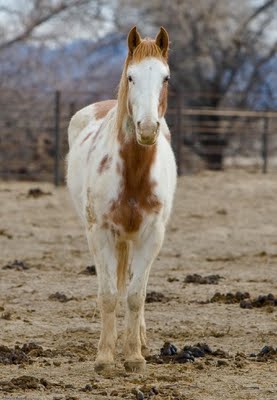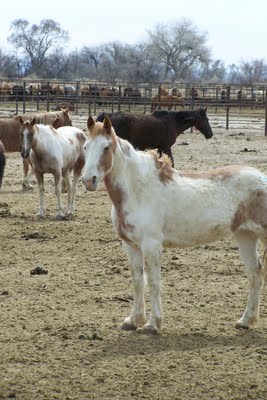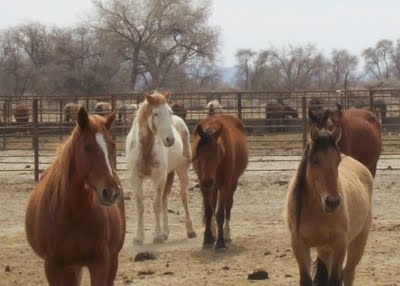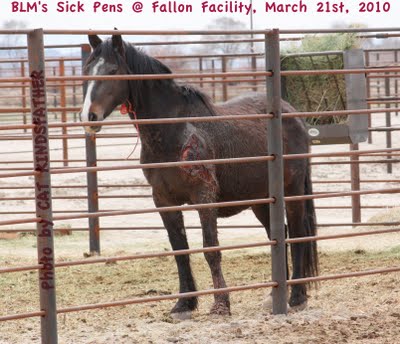


Seven Tears Into the Sea
Phantom Stallion Series

Bio
Weblog
Q&A
Schedule
Media



Sunday, April 11, 2010
Death in the Desert

Photo by Craig Downer
" What you are seeing are the remains of a wild horse, discovered by Craig Downer, Terri Farley, and Don Molde on a recent excursion into the Calico Mountains looking for the living remnants of the herds..."
To read a report by biologist Craig Downer and human observer Elyse Garder, click here:
Humane Observer Blog
This wide-ranging blog includes feelings and facts, comparing the past and present plight of the Calico Range horses, their capture, captivity and Craig's coverage of our first trip back to the Calico range following BLM's disastrous round-up.
Best,
Terri
Permalink to this blog post
Posted by Terri Farley @ 3:36 AM 2 comments


Monday, April 05, 2010
Ghost Dancer: still there
Dear Readers,
The Medicine Hat mare with the magnetic mood is still at the Indian Lakes BLM holding facility in Fallon.
She's shown here, photographed by Mark Terrell, just a few weeks after capture.

In these two photos -- one by Craig Downer and the other by Tara Kain -- she's been put in a pneumatic cage,vaccinated, hung with a red rope and numbered tag, then neck branded. You can see the freeze brand on her neck if you look closely. It will be there forever.
She looks thinner, even though food is delivered at the fence.

I'm calling this mustang Ghost Dancer because she once roamed Native American lands and the Ghost Dance ceremony was one of rebirth.
That's what I wish for these horses, a return to the range where their spirits can run free again.

Best to you all,
Terri
Permalink to this blog post
Posted by Terri Farley @ 2:52 AM 4 comments


Friday, April 02, 2010
Pigeon Fever Plagues Calico Horses

photo by Cat Kindsfather
Dear Readers,
The misery visited on the wild horses of the Calico mountains goes on.
Pigeon Fever was diagnosed by visitors to the feedlot style holding pens in Fallon, a place called Indian Lakes. Sounds nice, doesn't it?
Sadly, the photo I showed you a few days ago -- -shown again above -- could be a horse suffering from this condition.
Treatment for Pigeon Fever includes warm compresses, ISOLATION and hygenic conditions. Wild horses at Indian Lakes are getting none of this treatment.
Why?
"The incidence of Pigeon Fever at the Indian Lake Facility is at the same percentages that exist on the Calico Complex," BLM's contract vet, Dr. Sanford says, so "no treatments have been administered to date."
Even if this condition crops up on the range, too, horses running free do NOT stand around with two thousand other mustangs in crowded conditions where they can't avoid contact with each others' streaming pus.
Gross? Yes, and maybe that's why BLM is not only closing Indian Lakes to visitors on Easter Sunday, but director Don Glenn has refused to schedule a make-up day.
Secrecy leads to suspicion, and since day 1 of the Calico round up, it's been justified.
If BLM won't take even basic precautions -- like putting infected horses in hospital pens -- could it be because they want an excuse NOT to free them back to their home range? Or is it just too much trouble?
Best,
Terri
More info on Pigeon Fever from Colorado State veterinarians:
Clinical signs: Early signs can include lameness, fever, lethargy, depression and weight loss.
Infections can range from mild, small, localized abscesses to a severe disease with multiple massive abscesses containing liters of liquid, tan-colored pus.
External, deep abscesses, swelling and multiple sores develop along the chest, midline and groin area, and, occasionally, on the back.
Incubation period: Horses may become infected but not develop abscesses for weeks.
Animals affected:The disease usually manifests in younger horses, but can occur in any age, sex, and breed.
A different biotype of the organism is responsible for a chronic contagious disease of sheet and goats, Caseous lymphadenitis, or CL. Either biotype can occur in cattle.
Disease forms: Generally 3 types: external abscesses, internal abscesses or limb infection (ulcerative lymphangitis).
The ulcerative lymphangitis is the most common form worldwide and rarely involves more than one leg at a time. Usually, multiple small, draining sores develop above the fetlock.
The most common form of the disease in the United States is external abscessation, which often form deep in the muscles and can be very large. Usually they appear in the pectoral region, the ventral abdomen and the groin area. After spontaneous rupture, or lancing, the wound will exude liquid, light tan-colored, malodorous pus.
Internal abscesses can occur and are very difficult to treat
.
Treatment: Hot packs or poultices should be applied to abscesses to encourage opening. Open abscesses should be drained and regularly flushed with saline.
Surgical or deep lancing may be required, depending on the depth of the abscess or the thickness of the capsule, and should be done by your veterinarian.
Ultrasound can aid in locating deep abscesses so that drainage can be accomplished.
External abscesses can be cleaned with a 0.1 percent povidone-iodine solution
Antiseptic soaked gauze may be packed into the open wound
A nonsteroidal anti-inflammatory drug such as phenylbutazone can be used to control swelling and pain
Care required: Buckets or other containers should be used to collect pus from draining abscesses and this infectious material should be disposed of properly.
Consistent and careful disposal of infected bedding, hay, straw or other material used in the stall is vitally important.
Thoroughly clean and disinfect stalls, paddocks, all utensils and tack.
Pest control for insects is also very important.
Recovery time: Usually anywhere from two weeks to 77 days.
Permalink to this blog post
Posted by Terri Farley @ 3:01 PM 5 comments


Wednesday, March 31, 2010
Let 'em Run

Dear Readers,
The captive wild horse above is the reason that I've barely talked with you since biologist Craig Downer and I returned from BLM's Fallon corrals, Sunday, then searched out remnants of the wild herds of the Calico range on Monday.
Every spare hour since then, we've worked toward this:
FEDERAL LAWSUIT AGAINST WILD HORSE ROUNDUP SEEKS RETURN OF 1800 HORSES TO NEVADA RANGE
When photographer Cat Kindsfather enlarged this photo, she realized that the seepage from this mustang's awful wound had pulsed all the way down to his hoof.
This callous cruelty cannot be allowed to continue.
Terri
Permalink to this blog post
Posted by Terri Farley @ 10:26 AM 3 comments


Monday, January 04, 2010
A STALLION NAMED FREEDOM loses everything else

Pursued by a helicopter, Freedom's herd heads toward a trap
Update From The Field
By Craig C. Downer, Wildlife Ecologist
and Elyse Gardner, Public Observer
January 2, 2009
Below are the photos of the roundup that took place today (Saturday, January 2, 2009) showing how the captured band stallion, "Freedom," valiantly fought for and regained his liberty although he had to leave his family of 8 adult mares and 2 colts. Jumping a 6-foot fence and immediately thereafter breaking through a barbed wire fence and injuring himself, this was an awe-inspiring, do-or-die effort demonstrating the loathing of captivity to a wild horse and his need for freedom. We can only pray for his recovery from the injuries the sustained from the barbed wire.






FOR THE COMPLETE STORY, VISIT: http://humanitythrougheducation.com/
Additional Note: On New Year's Day, the BLM rounded up 10 wild horses but only captured 9 because a 6-month old foal died en route. APHIS vet at the scene, Dr. Al Kane, reported that after being chased by the helicopter for "1/4 mile" the little foal was behaving strangely, lying down periodically. It is reported that the pilot radioed Dr. Kane that this foal was having problems and Dr. Kane went out to see the foal who was found dead. Dr. Kane said that he did a necropsy in the field and discovered congenital heart defect and said that foal couldn't have handled any exercise and probably wouldn't have lived to adulthood. They left the body in the field and refused to allow the public observers to witness the body.
Permalink to this blog post
Posted by Terri Farley @ 8:02 AM 5 comments


Death in the Desert
Photo by Craig Downer
" What you are seeing are the remains of a wild horse, discovered by Craig Downer, Terri Farley, and Don Molde on a recent excursion into the Calico Mountains looking for the living remnants of the herds..."
To read a report by biologist Craig Downer and human observer Elyse Garder, click here:
Humane Observer Blog
This wide-ranging blog includes feelings and facts, comparing the past and present plight of the Calico Range horses, their capture, captivity and Craig's coverage of our first trip back to the Calico range following BLM's disastrous round-up.
Best,
Terri
Labels: BLM, BLM round ups, Calico Complex, Craig Downer, Elyse Gardner, mustang deaths, wild horses
Permalink to this blog post
Posted by Terri Farley @ 3:36 AM 2 comments
Monday, April 05, 2010
Ghost Dancer: still there
Dear Readers,
The Medicine Hat mare with the magnetic mood is still at the Indian Lakes BLM holding facility in Fallon.
She's shown here, photographed by Mark Terrell, just a few weeks after capture.

In these two photos -- one by Craig Downer and the other by Tara Kain -- she's been put in a pneumatic cage,vaccinated, hung with a red rope and numbered tag, then neck branded. You can see the freeze brand on her neck if you look closely. It will be there forever.
She looks thinner, even though food is delivered at the fence.

I'm calling this mustang Ghost Dancer because she once roamed Native American lands and the Ghost Dance ceremony was one of rebirth.
That's what I wish for these horses, a return to the range where their spirits can run free again.

Best to you all,
Terri
Labels: Craig Downer, Fallon, Indian Lakes, Medicine Hat, mustang, terri farley, wild horses
Permalink to this blog post
Posted by Terri Farley @ 2:52 AM 4 comments
Friday, April 02, 2010
Pigeon Fever Plagues Calico Horses
photo by Cat Kindsfather
Dear Readers,
The misery visited on the wild horses of the Calico mountains goes on.
Pigeon Fever was diagnosed by visitors to the feedlot style holding pens in Fallon, a place called Indian Lakes. Sounds nice, doesn't it?
Sadly, the photo I showed you a few days ago -- -shown again above -- could be a horse suffering from this condition.
Treatment for Pigeon Fever includes warm compresses, ISOLATION and hygenic conditions. Wild horses at Indian Lakes are getting none of this treatment.
Why?
"The incidence of Pigeon Fever at the Indian Lake Facility is at the same percentages that exist on the Calico Complex," BLM's contract vet, Dr. Sanford says, so "no treatments have been administered to date."
Even if this condition crops up on the range, too, horses running free do NOT stand around with two thousand other mustangs in crowded conditions where they can't avoid contact with each others' streaming pus.
Gross? Yes, and maybe that's why BLM is not only closing Indian Lakes to visitors on Easter Sunday, but director Don Glenn has refused to schedule a make-up day.
Secrecy leads to suspicion, and since day 1 of the Calico round up, it's been justified.
If BLM won't take even basic precautions -- like putting infected horses in hospital pens -- could it be because they want an excuse NOT to free them back to their home range? Or is it just too much trouble?
Best,
Terri
More info on Pigeon Fever from Colorado State veterinarians:
Clinical signs: Early signs can include lameness, fever, lethargy, depression and weight loss.
Infections can range from mild, small, localized abscesses to a severe disease with multiple massive abscesses containing liters of liquid, tan-colored pus.
External, deep abscesses, swelling and multiple sores develop along the chest, midline and groin area, and, occasionally, on the back.
Incubation period: Horses may become infected but not develop abscesses for weeks.
Animals affected:The disease usually manifests in younger horses, but can occur in any age, sex, and breed.
A different biotype of the organism is responsible for a chronic contagious disease of sheet and goats, Caseous lymphadenitis, or CL. Either biotype can occur in cattle.
Disease forms: Generally 3 types: external abscesses, internal abscesses or limb infection (ulcerative lymphangitis).
The ulcerative lymphangitis is the most common form worldwide and rarely involves more than one leg at a time. Usually, multiple small, draining sores develop above the fetlock.
The most common form of the disease in the United States is external abscessation, which often form deep in the muscles and can be very large. Usually they appear in the pectoral region, the ventral abdomen and the groin area. After spontaneous rupture, or lancing, the wound will exude liquid, light tan-colored, malodorous pus.
Internal abscesses can occur and are very difficult to treat
.
Treatment: Hot packs or poultices should be applied to abscesses to encourage opening. Open abscesses should be drained and regularly flushed with saline.
Surgical or deep lancing may be required, depending on the depth of the abscess or the thickness of the capsule, and should be done by your veterinarian.
Ultrasound can aid in locating deep abscesses so that drainage can be accomplished.
External abscesses can be cleaned with a 0.1 percent povidone-iodine solution
Antiseptic soaked gauze may be packed into the open wound
A nonsteroidal anti-inflammatory drug such as phenylbutazone can be used to control swelling and pain
Care required: Buckets or other containers should be used to collect pus from draining abscesses and this infectious material should be disposed of properly.
Consistent and careful disposal of infected bedding, hay, straw or other material used in the stall is vitally important.
Thoroughly clean and disinfect stalls, paddocks, all utensils and tack.
Pest control for insects is also very important.
Recovery time: Usually anywhere from two weeks to 77 days.
Labels: BLM, Craig Downer, Don Glenn, Fallon, Fallon facility, Indian Lakes, Pgeon Fever, terri farley
Permalink to this blog post
Posted by Terri Farley @ 3:01 PM 5 comments
Wednesday, March 31, 2010
Let 'em Run
Dear Readers,
The captive wild horse above is the reason that I've barely talked with you since biologist Craig Downer and I returned from BLM's Fallon corrals, Sunday, then searched out remnants of the wild herds of the Calico range on Monday.
Every spare hour since then, we've worked toward this:
FEDERAL LAWSUIT AGAINST WILD HORSE ROUNDUP SEEKS RETURN OF 1800 HORSES TO NEVADA RANGE
When photographer Cat Kindsfather enlarged this photo, she realized that the seepage from this mustang's awful wound had pulsed all the way down to his hoof.
This callous cruelty cannot be allowed to continue.
Terri
Labels: BLM, Craig Downer, Fallon, lawsuit, mustangs, terri farley, wild horse deaths, wild horse injuries, wild horses
Permalink to this blog post
Posted by Terri Farley @ 10:26 AM 3 comments
Monday, January 04, 2010
A STALLION NAMED FREEDOM loses everything else

Pursued by a helicopter, Freedom's herd heads toward a trap
Update From The Field
By Craig C. Downer, Wildlife Ecologist
and Elyse Gardner, Public Observer
January 2, 2009
Below are the photos of the roundup that took place today (Saturday, January 2, 2009) showing how the captured band stallion, "Freedom," valiantly fought for and regained his liberty although he had to leave his family of 8 adult mares and 2 colts. Jumping a 6-foot fence and immediately thereafter breaking through a barbed wire fence and injuring himself, this was an awe-inspiring, do-or-die effort demonstrating the loathing of captivity to a wild horse and his need for freedom. We can only pray for his recovery from the injuries the sustained from the barbed wire.






FOR THE COMPLETE STORY, VISIT: http://humanitythrougheducation.com/
Additional Note: On New Year's Day, the BLM rounded up 10 wild horses but only captured 9 because a 6-month old foal died en route. APHIS vet at the scene, Dr. Al Kane, reported that after being chased by the helicopter for "1/4 mile" the little foal was behaving strangely, lying down periodically. It is reported that the pilot radioed Dr. Kane that this foal was having problems and Dr. Kane went out to see the foal who was found dead. Dr. Kane said that he did a necropsy in the field and discovered congenital heart defect and said that foal couldn't have handled any exercise and probably wouldn't have lived to adulthood. They left the body in the field and refused to allow the public observers to witness the body.
Labels: BLM lawsuit, Craig Downer, Elyse Gardner, Freedom, round ups, stallion escapes, terri farley, wild horses
Permalink to this blog post
Posted by Terri Farley @ 8:02 AM 5 comments